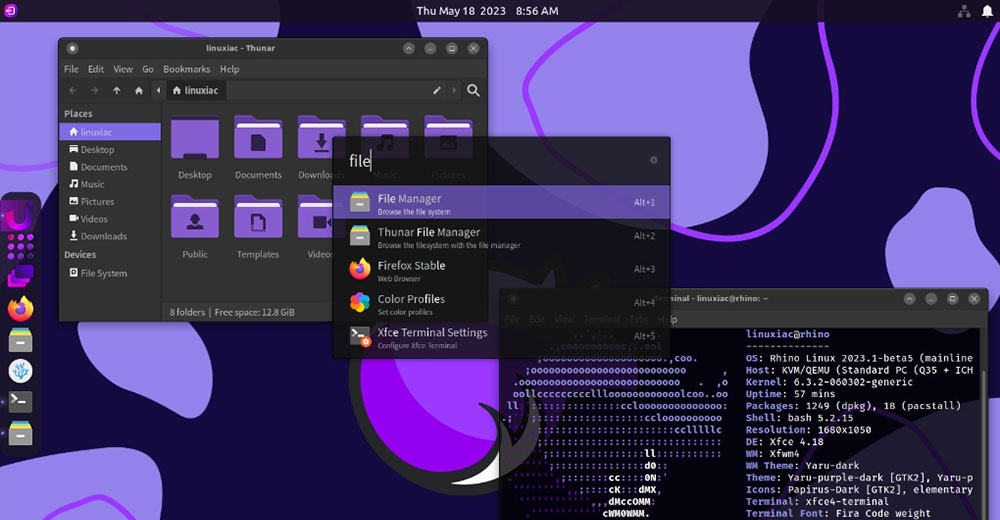Rhino Linux takes an already fine Xfce desktop and blends in elements of the GNOME graphical interface to create a hybrid desktop design well worth experiencing.
The combination does for me what few other new Linux distributions have done; it has me waiting very impatiently for the first non-beta release. However, since my initial interaction with this promising distro a couple of months ago, that wait has extended into the summer season.
The resulting desktop retains the awesome flexibility of Xfce and adds some of the more useful conventions of GNOME with a few feature dashes based on in-house artistry. For Linux users clamoring for a touch of rolling release updates to a solid Ubuntu base, Rhino Linux checks all the usability and appearance boxes missing in other alternatives.
Rhino is still a work in progress after resuming development where its predecessor — Rolling Rhino Remix — left off. That forerunner built by an otherwise nameless developer self-dubbed “http.llamaz” offered a rolling-release unofficial variant of Ubuntu.
Related: Rhino Linux Unleashes First Rolling Release Ubuntu Stable Edition | Aug.15, 2023
Under new development since October, the Rhino team released the fifth beta edition in mid-May. A news announcement on the website admitted that initial projections to release the first stable addition in March failed due to underestimating the scale of work needed.
With new developers added, the revamped distro’s stable release was first expected this summer. But as of this writing, developers only reached version 2023.1-beta 7. So my wait continues with the hope that the non-beta release will come soon.
Based on the performance of the current beta release, that goal seems feasible. My hands-on tour of Rhino Linux revealed only a few flaws and numerous smiles as I traipsed around the menus, desktop, and system settings.
Game of Anonymity
The new developers remain nameless and are difficult to reach. I found no valid contact information on the new website. The latest Rhino Linux website still has old contact us links to previous locations and YouTube channels. I could only find the reference on LinkedIn to an unidentified Rhino Linux System Developer at RhinoLINUX Projects based in South Africa.
That level of anonymity among Linux project developers always raises reliability issues for me. Another precaution I apply when assessing distributions to review is their beta status. So far, I am impressed with the beta functionality of Rhino Linux.
Its approach to the desktop is enticing. If you are curious about checking out this “reimagined” new direction for the Rhino Linux project, be sure you go to the correct URL: rhinolinux.org.
The Rolling Rhino website is still live but no longer dispensing updated ISOs for installation. Also, do not confuse Rhino Linux with BlackRhino GNU/Linux distro, which is discontinued and based on Debian Linux built for PlayStation.
With all that said, let’s pursue what intrigues me about the new Rhino Linux.
Tweaked Parts Make a Better Whole
The Xfce desktop has been my long-time favorite and continues to power my collection of aging workbench computers. Rhino has the latest Xfce 4.18 environment, modified to provide a more modern user experience.
I was at first disappointed to find the trappings of mostly some GNOME desktop appearances, such as a full-screen app grid menu and a sliding side panel virtual desktop switcher. But then I found the critical features that always keep me coming back to Xfce.
For instance, the top panel has a built-in menu of options for what items to add or remove. While the GNOME-style full-screen grid applications menu, called Lightpad, is launched by clicking a button on the plank, a panel plugin lets you add the Whisker app menu.
One of my favorite Xfce desktop features is the context-based right-click mouse launcher. That, too, remains available in Rhino Linux.
As noted, this hybrid desktop lets you use both approaches. Overall performance was impressive, and the default Calamares installer is easy to use and reliable.
Simple Yet Smart
Despite running in live mode and then installed in a virtual machine, Rhino Linux showed no signs of flutter, lag, or strain in showing off its stuff. It is quick and easy to use.
One of Rhino’s core parts is Pacstall (still in the early stages of development) rather than Xfce to handle system maintenance, kernel installations, dot files, the default Plymouth theme, and many more. All system-related packages are bundled as a pacscript.
But Rhino still uses a somewhat conventional desktop layout as the default interface, with the panel at the top of the screen and a plank at the center of the left edge of the screen. Though similar to GNOME’s left-edge vertical panel, it holds only essential launchers with the menu button at the top rather than on the panel or in the left upper corner.
No-Brainer Setup Aids
When first running Rhino Linux, you tour through a welcome sequence to make initial feature selections. The graphical application gives the option to install useful software or additional package managers.
Even better is the roughly half-dozen individual configuration panels that let you fine-tune how you want to use the desktop. Since each settings panel is standalone, you will not get lost in a maze or confusing options.
Application housekeeping is handled by the in-house Rhino package tool. It searches, installs, removes, adds, and updates packages from multiple sources, such as native DEB repositories, Pacstall, Flathub, and Snap Store. For those so inclined, simple terminal outputs enhance the process.
Using the package manager panel, you can select one or more of the included tools — Flatpack, Snap, and Appimage.

Rhino-pkg, which handles these options, is an in-house created wrapper for APT, Pacstall, Flatpack, and Snap.
Workspace Winner
Over the years, I have become somewhat lukewarm about the GNOME desktop. The single most significant dislike is for the way it handles desktop workspaces.
I never found convenience or efficiency in constantly having to push the pointer into a corner or click on a launcher to activate a slide-out overview column from the screen’s right edge.

Then clicking on a desktop view and dragging a running app to another workspace is the wrong way to navigate. GNOME lacks a right-click capacity to send an app to another workspace. That ability in Rhino Linux, despite the otherwise solid Xfce underbelly, is also missing.
However, adding the Workplaces and Windows menu plugins to the top panel takes away some of that user pain I feel. The plugins make virtual desktop navigation closer to an Xfce solution than the modified GNOME approach.
Bottom Line
Rhino Linux creates a workable and pleasant hybrid desktop that combines the best features of both GNOME and Xfce. The beta version is thinly packed in terms of applications.
The lack of productivity tools and much in the way of office programs limits Rhino’s usefulness now. But once the first stable edition arrives, this newly reconstituted distribution will provide a highly recommendable Linux operating system.
Suggest a Review
Is there a Linux software application or distro you’d like to suggest for review? Something you love or would like to get to know?
Email your ideas to me, and I’ll consider them for a future column.
And use the Reader Comments feature below to provide your input!


























































Thank you Jack. Does its desktop only look a little bit like GNOME, or does it also support GNOME “shell” extensions?
I do see pacstall.dev/packages?filter=gnome&filterBy=name -> pacstall.dev/packages/gnome-shell-extension-installer-git -> github.com/pacstall/pacstall-programs/blob/master/packages/gnome-shell-extension-installer-git/gnome-shell-extension-installer-git.pacscript. But, does that look too good to be true? Or is that enough to run GNOME (shell) extensions?
I’ve installed it in Virtual Box, but Virtual Box Guest Additions couldn’t compile on it. I’ll try it again in half a year.
Do we REALLY need yet another distro??
Let’s be honest with ourselves here. Linux is NEVER going to replace Winblows or MacOS. It won’t even come close. The only real chance to compete, if in fact, that is what they really want to do, is to reduce the dilution of the OS. Sure, one could argue that customization and choice is a hallmark of Linux, and I would agree. But we are perpetuating a self-limiting prophecy.